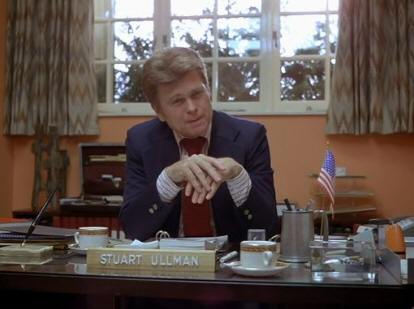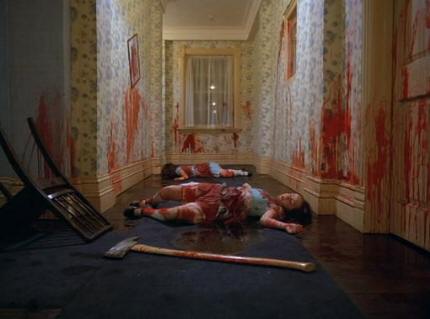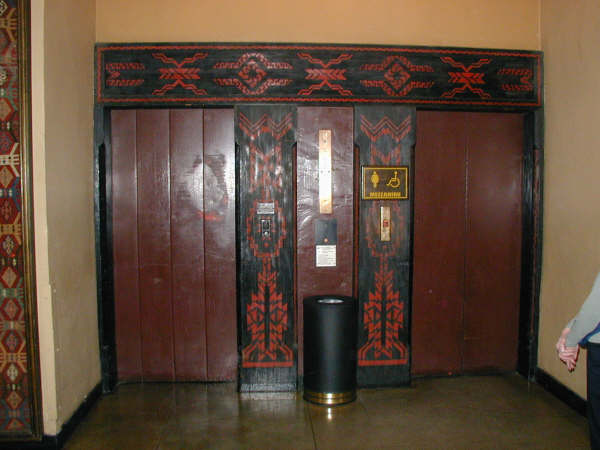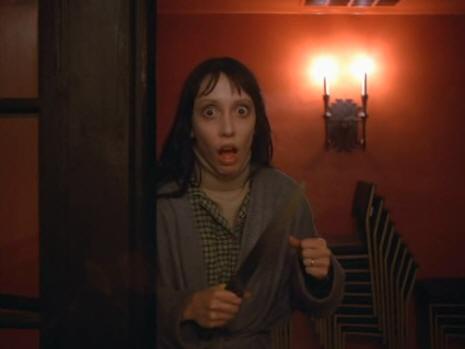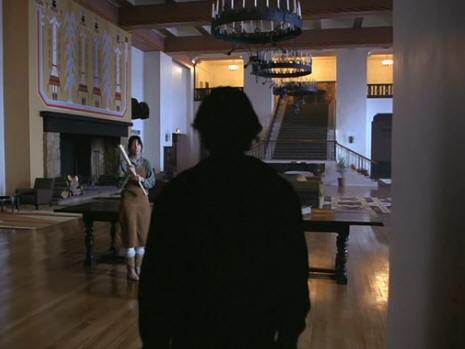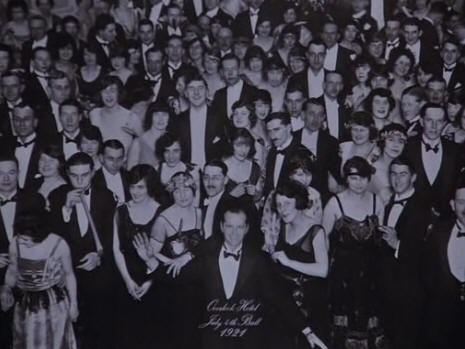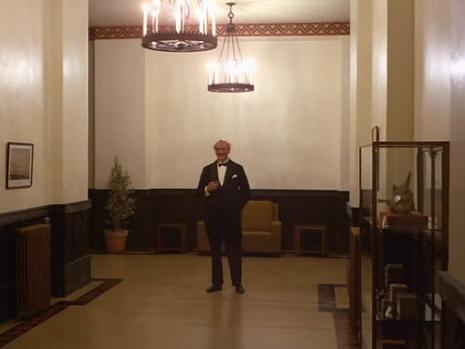CHAPTER TWELVE
Watch the video supplement or read the ext below (there are differences between these versions)
Now we come to the first of several controversial themes in The Shining – the genocide of Native Americans in early US history. I covered this topic extensively in my previous analysis, in fact it was the main premise of the review, but due to the greatly extended length of this current analysis, the genocide theme will cease to be my central contention about the film’s meaning. I’ll also be changing some of the basic premises of this theme and adding several new details and observations. Occasionally, youtube viewers have accused me of imposing an anti-American political view upon The Shining and that in their opinion the film only contained circumstantial Native imagery. This kind of feedback has virtually always come from American viewers of my videos and so I can only conclude that they felt their heritage was being insulted by my interpretations. So before I continue, I’ll offer a few statements for those who disapprove of the genocide interpretation. The first thing to note is that if you explore my other videos and articles you’ll find that I have more negative things to say about my own country than any other. I’m well-aware that England has a long history of imperialism, slavery and genocide that goes way further back in history than that of the US. In particular my interpretations of Kubrick’s A Clockwork Orange and Eyes Wide Shut could just as easily be taken as Anti-English. Another factor is that Stanley Kubrick was American himself, so these genocide themes can’t be written off as an external attack on American pride. His decision to relocate out of America may have been partly due to some dissatisfaction he felt with with the US. I’ll also add that if you’re willing to stomach the criticism of US history contained in this chapter, you’ll find later in this analysis that Kubrick encoded scathingly anti-British themes in The Shining as well. And for those wishing to know my personal stance on this issue, I’ll state for the record that I have very positive views on the US Declaration of Independence. The Constitution and Bill of Rights were great documents, and I’m sure most American’s would agree with my disapproval of how the US government has in recent years been destroying those founding documents. So now let’s crack on with the analysis of Kubrick’s subliminally encoded genocide theme.
While being shown through the Colorado Lounge Wendy asks Ullman “Are all these Indian designs authentic?” and he replies, “I believe most are based mainly on Navajo and Apache motifs.” Then in the Overlook grounds Ullman explains to the Torrance’s “The hotel is built on an old Indian burial ground and I believe they actually had to repel a few Indian attacks as they were building it.” Ullman also told Jack Torrance during his interview that the “construction began in 1907 and was finished in 1909.” Can this really be the case? I’m no expert on US history, but didn’t most of the clashes between native tribes and settlers take place in the hundreds of years prior to the twentieth century? However, if we remember that Kubrick has symbolically presented the Overlook as a representation of America itself then Ullman’s statement makes sense. The settlers did fight off several “Indian attacks” as they were building their new country. In the interview scene Ullman has a small US flag on his desk, which is not unusual in the United States, but notice that he is also wearing red, white and blue.
Perhaps intentionally, Danny was also wearing a red, white and blue shirt in his scenes back in Boulder.
An apparent continuity error in the Boulder scenes is that a British Type G (three-pin) socket is shown in the upper right as Danny talks to him self in the bathroom mirror (see above). The film was shot in England so it could just be a mistake. On the other hand, the metaphor of the Overlook as America suggests that the Torrance’s are symbolic settlers. During their drive to the Overlook they even enter into a conversation about settlers. Wendy, “Wasn’t it around here that the Donner party got snowbound?” Jack, “I think that was further west in the Sierra’s.” Danny, “What was the Donner party?” Jack, “They were a party of settlers in covered wagon times. They got snowbound one winter in the mountains and they had to resort to cannibalism in order to survive.” The Donner Party cannibalism tragedy was a real part of American history, but Jack’s explanation of it is also symbolic of the coming events for his family. They travel to a hotel that represents America and they become snowbound. Jack then goes crazy and tries to kill his family. And in reference to cannibalism, he calls his family “little pigs” through the bathroom door while doing his big bad wolf impression, implying a desire to eat them. Danny told his Mother during the drive to the Overlook, “Don’t worry Mom. I know all about Cannibalism. I saw it on TV.” Of course he saw it on television – he was watching Roadrunner cartoons, in which Wile E. Coyote tries to catch and eat the Roadrunner. Food is emphasized a great deal in the film, especially in the scenes of Halloran rambling on about all the different types of food in the freezer room and store room. There’s also an emphasis on ketchup. Danny says French fries and ketchup are his favourite food. The camera passes over stacks of giant ketchup tins in the store room – maybe foreshadowing the river of blood and further hinting at cannibalism.
The words “Sliced Peaches” are also seen on boxes in the store room when Jack talks through the door to Grady
In fact there are several very specific uses of brand names in the store room scenes that relate to other subliminal themes, but we’ll return to that later. Moving on from cannibalism, let’s take a closer look at the hotel décor. Although the exteriors of the Overlook are based on The Timberline Lodge, its interiors are inspired by another real life hotel called the Ahwahnee. The photos contained in the following link were sent to me by a former employee of the Ahwahnee in response to my first video analysis of The Shining. As you can see the similarities are unmistakeable. Ahwahnee interior designs. The Ahwahnee hotel also features a large room called the El Dorado Diggins bar which is themed to the California Gold Rush period.
The mining of gold was an important motive for early settlers and so Kubrick has included a Gold Room in the Overlook hotel, where Jack reminisces with his own past. Its design is very different to the one in the Ahwahnee hotel for reasons which we shall explore in the next chapter. The Ahwahnee design includes plenty of Native American designs in its tapestries and carpets, just as the Overlook does, but there are some key differences of native décor related to The Shining’s hidden narrative. Perhaps the biggest differences are in the Colorado Lounge. Large US and Colorado flags hang above Jack’s writing space in The Shining, but are not featured in the Colorado Lounge at the Ahwahnee.
Kubrick also includes these same flags in the games room set where Danny plays darts.
But the most important difference is that in The Shining Kubrick has included a giant painting of symbolic figures above the Colorado Lounge fireplace.
This is actually a form of Navajo Indian art called a sand painting and its contents hold great symbolic meanings in their culture.
The Colorado Lounge at the Ahwahnee does not feature sand paintings. We could just pass this off as an aesthetic “it looks cool” choice on Kubrick’s part. That is until we pay attention to how the sand painting is used in different scenes. Remember that Jack’s throwing of a tennis ball is used symbolically in the film as a metaphor for axe swinging. In one scene Jack repeatedly throws the tennis ball at the figures featured in the sand painting. One of the figures is dressed in the same shade of blue as the dead twins who Danny saw with an axe near their bodies.
The symbolic connections are undoubtedly deliberate. The murders at the Overlook represent the historical genocide of Native Americans and Jack and his alter-ego Grady represent the perpetrators of the atrocities. Some Navajo sand paintings feature a set of twin figures symbolising Father sky and Mother Earth, which may also be related to the twin concept in The Shining.
The placement of the sand painting figures above a fireplace could even be symbolic of genocide in a sacrificial sense. Incidentally, the imaginary room 237 featured in Danny’s nightmares is almost directly behind the sand painting fireplace. This further supports the theme of room 237 and the Torrance apartment being one and the same. He throws a tennis ball at one and an axe at the other. Another Native American symbol that may have been deliberately referenced in the maze scenes of The Shining is the widely used Man in the Maze symbol, featured below.
Some email correspondents have also told me that an old Indian warrior trick was to backtrack in their own footsteps to evade detection, just like Danny does. However, I’ve been unable to verify this in online searches. (If any readers of this article are aware of sourced references to this please email me the details. Thanks) Jack offers a hint of his pro-genocide philosophy while talking Lloyd in the Gold Room, “White man’s burden, Lloyd my man. White man’s burden.” White Man’s Burden is a Rudyard Kippling poem that was historically used in the US as a justification for white rule over other races. Jack then follows this up with another innuendo relating to settlers in covered wagon times, “Here’s to five miserable months on the wagon, and all the irreparable harm it’s caused me.” His conversation with Grady in the lavatory clearly has a racial hatred element. Grady, “Your son is attempting to bring an outside party into this situation … A nigger.” This of course refers to Halloran, the only character in the film who Jack kills. As a side-note, Kubrick gave readers of the book an unpleasant surprise with his use of the Halloran character. In the book Halloran rescues Danny and Wendy from Jack, but in the film he is unexpectedly axed to death. Halloran’s character is important because he represents both the slaughtered Native American’s and the Black immigrants who were brought in for slavery purposes. He looks very much like a cross-breed between the two races and as head chef, he is a servant of his county’s white guests. His cross-symbolism with natives is demonstrated in the first store room scene. As Danny hears the line “How’d you like some ice cream Doc”, a tin of Calumet baking powder is placed behind Halloran’s head. Both Halloran and the Indian chief design on the tin are viewed at the same angle and the shot zooms in until both their heads fill the screen. Is he a head chef or a chief's head?
The Calumet Baking Powder company is a real business, established in 1889, but this doesn’t mean its presence here is not symbolic. Kubrick often would incorporate real places, products and historical events that circumstantially fitted in with whatever he wanted to communicate. In the documentary Kubrick’s Boxes, some of the research materials in his archives showed just how far he was willing to go in seeking out real world symbols in support of his subliminal narratives. For a simple gate prop in Eyes Wide Shut Kubrick had a photographer take thousands of photos of real gates as reference material. The documentary narrator seemed baffled by this, but it makes very good sense when we take into account that Kubrick attempted to weave symbolism into every creative choice in his film projects. The more aesthetic choices he had, the better. A stack of Calumet tins are also shown behind Jack’s head when he is locked in the store room.
He holds his hand up to his injured head to soothe the pain, which could also be symbolic of his tormented guilt relating to America’s repressed history of Native genocide, which some researchers have claimed to be as horrific as the holocaust (1) (2). Halloran talks of a hidden history to Danny in the kitchen, “I think a lot of things happened in this particular hotel (country) over the years and not all of ‘em was good.” Guilt and denial are essential psychological devices in The Shining. Jack’s guilt about his abusive behaviour toward his son is accompanied by his wife’s denial of the issue and by Danny’s trauma-induced amnesia, but they’re also manifested in terms of genocidal history. In today’s climate of hypocritical equality propaganda American’s are much more aware of this dark aspect of US history, but in 1979, when The Shining was released, it would have been a much more tabboo subject. Hence Kubrick relied on subliminal encoding to bypass potential controversy. Genocide and slavery symbolism creeps into the film on many more levels. In particular, Wendy’s character has been radically altered from a strong and independent blonde in the book to a whimpering dark haired geek in the film who is frequently dressed like a Native American woman.
Jack shows very little love or affection toward her and she waits on him hand and foot, making all the meals and running the boilers in the grimy basement. This is ironic, considering it was Jack who was interviewed for the job. Even the hotel manager, Ullman, seemed to view Wendy as little more than slave labour. While showing the Torrance couple around, he asks Halloran to show Wendy the kitchen – instantly he is assuming her role as a menial worker. Then when he returns to meet her in the kitchen he makes the same assumption, “Dick, can we borrow Mrs Torrance for a few minutes. We’re on our way through to the basement. I promise we won’t keep her very long.” Again there is an unspoken agreement that she will carry out the menial tasks. It's also worth noting that in order to gain citizenship in their own land after the founding of the US, many Indian women would marry white men. No doubt they were still seen as second class citizens. So perhaps it could be this factor that gives Jack his consistent temper and frustration with his wife. She reminds him of the atrocities committed against these native people. A memory he would much prefer to deny, as some people still do even to this day. When Jack and Grady chat in the lavatory, during the ballroom party, a song by Ray Noble and Al Bowlly plays in the background. It includes the following lyrics, “It's all forgotten now, the trouble and the pain, forgot in every word I say, forgot in every tear you shed ... our troubles are beyond recall ...”. These lyrics parallel Jack’s repression of genocidal history. The native themes are also manifested in the film’s score. In the opening mountain shots echoed tribal chanting can be heard along with what sound very much like terrified screams. A Penderecki piece, which features native-instrument-like sounds and ritualistic vocals, is used six times – As Wendy sees Danny’s “MURDER” graffiti in a mirror, as Jack kills Halloran, as Jack begins chasing Danny, as Wendy sees Halloran’s body, as she see the party guest, and as she sees the man in a bear costume. One of the most baffling shots is the river of blood emerging from an elevator.
This isn’t just a random aesthetic to scare us. It was used in the very creepy trailer for the film and it pops up in several scenes. The first thing to note is that its design is plucked straight from a lavatory entrance in the Ahwahnee hotel.
Perhaps this is related to the red décor of the lavatory scene where Jack has his racist chat with Grady – implying a genocidal bloodbath. A consistent use of the river of blood image is that it is intercut with shots of Danny screaming directly at the camera with his eyes wide open.
The two floor dials above the elevator doors look suspiciously like glaring eyes and so it seems that Kubrick used the elevator to represent a giant gaping mouth.
This may seem a bit of a stretch, but an important indicator is that the Ahwahnee hotel is located within the Yosemite valley, through which a river runs called the Merced. The Ahwahnee hotel also gets its name from a Miwok tribe called the Ahwahneechees - it translates as “Valley of the gaping mouth”. The Miwok tribe were apparently almost wiped out by disease and had to leave the now renamed Yosemite Valley, hence the Europeans took their place. So considering all the other native genocide references in The Shining, my interpretation is that the river of blood hallway and elevator does indeed represent a gaping mouth in a valley, from which a river of Native American screams and blood are flowing.
A chorus of screams is heard over the elevator shot while Jack and Wendy argue in the bedroom. And the final instance, in which Wendy sees the river of blood, is accompanied by a shot of her terrified face, eyes and mouth wide open. Note that she also looks as if she’s choking, just as Danny was choked by Jack.
The first showing of the blood river, in Danny's first shining version, is accompanied by a rumbling noise, which can be interpreted as the sound of flowing water or the deafening simultaneous screams of thousands or even millions of Native Americans. The river of blood is the final shot of the hotel interior, except for the shot of Jack in the old photo. It seems to indicate a final revelation of America’s hidden history of native genocide. Once Danny and Wendy’s eyes are wide open to this truth they are free to make their escape. Jack’s apparent familiarity with the classically English party guests supports the notion of the family as trans-atlantic settlers. We’ve already identified that his conversation with the Englishman Grady was a conversation with his own reflection. For a more powerful example of Jack’s double identity as an Englishman compare the following two scenes. In the Colorado lounge Wendy discovers Jack's insane manuscript. We cut to a dark and out of focus shot of ballroom photos, which strafes left until we see Wendy reading the manuscript again. An unidentified silhouette steps in from the right. We then hear Jack's voice “How do you like it”. Wendy screams and faces him. Jack has just metaphorically stepped out of the black and white photos of the past and into the present.
Remember that the final shot of the film shows that he was already in the old photos to begin with.
The manuscript scene ends with Jack taking a whack on the head from a baseball bat, from which he bleeds.
Now let's observe the scene where Wendy discovers Halloran's body. She sees his bloody corpse lying on a native art section of floor tiles and the camera also pans across an elevator entrance that is identical to the one from which we see the river of native blood.
Then without seeing or hearing anything she screams and spins to face an apparition that has stepped in from some unknown direction. Just like Jack in the manuscript scene, the ghostly Englishman has stepped in from some mysterious direction. The bleeding gash on his head also parallels Jack's head injury from the baseball bat.
The reason she knew the apparition was there before facing it was that the scene was a repetition of when she was startled by Jack while reading the manuscript. It's as if Jack had let her see Halloran's body and then startled her again by repeating his line “How do you like it?” The Englishman is Jack Torrance, just as Lloyd and Grady were. The themes of a suppressed history of violence and bloodshed in the US are one of Kubrick’s central political themes in The Shining. The Overlook Hotel is a representation of what the settlers have built – a society that is a beautiful paradise on the surface, yet it has menial workers slaving away to maintain the affluence of the upper classes and it forever stands upon the graves of the Indians. The films' characters represent players in the history of America. Their actions are driven by fear, guilt and denial of what is buried in their past, and which seems destined to repeat itself in an eternal time loop. The famous shot of what appears to be a young Jack Torrance waving to us in an old photo is undoubtedly part of the film’s cryptic messages. The photo is labelled 4th July ball 1921. The 4th of July is of course the declaration of independence, the most important day in US history, but what about the mysterious year 1921? Then there’s the mystery of Jack’s manuscript. The aesthetic overlaps between Wendy discovering the manuscript and discovering Halloran’s body suggest that the manuscript is somehow symbolic of Jack’s genocide motive. Notice that as Jack is typing just before Wendy enters and interrupts him, a close up of his face shows one of the gaping mouth elevator doors directly behind his head – maybe an association between his writing and the river of Native blood.
Another clue is that the shot of Jack throwing a tennis ball (axe) at the Navajo sand painting begins as a close up of his type writer.
Jack absolutely disapproves of any attempt by Wendy, his symbolic Native American wife, at reading anything he has written. Although a large scrap book placed on the desk as he writes appears to contain newspaper clippings, which suggests that his writings are history related.
And then there’s the cross-symbolism between “murder” And “play” suggested at many points in the story, which is most prominent in the dead twins scene. The girls are heard asking Danny to “come and play” with them before we see their blood soaked corpses. Every page of Jack’s documents repeats the phrase “All work and no play (murder) make Jack a dull boy.” He seems to be writing something that will result in murder or genocide. Whatever the content of the document, it is something that Jack considers far more important than his own family. “DOES IT MATTER TO YOU AT ALL THAT THE OWNERS HAVE PLACED THEIR COMPLETE CONFIDENCE AND TRUST IN ME AND THAT I HAVE SIGNED A LETTER OF AGREEMENT … A CONTRACT !? … IN WHICH I HAVE ACCEPTED THAT RESPONSIBILITY.” In my previous analysis I put forth the contention that the manuscript was a metaphor of the written declaration of independence, but having discussed the issue at length with many correspondents, I’ve now dropped that interpretation. The Declaration of Independence was not in itself the cause of genocide in the US. Another possible meaning for the manuscript is that it could represent the Indian Removal Act, which was a key document that resulted in many native deaths. This would certainly tie in with the genocide themes. There are more possibilities to consider though.
|
